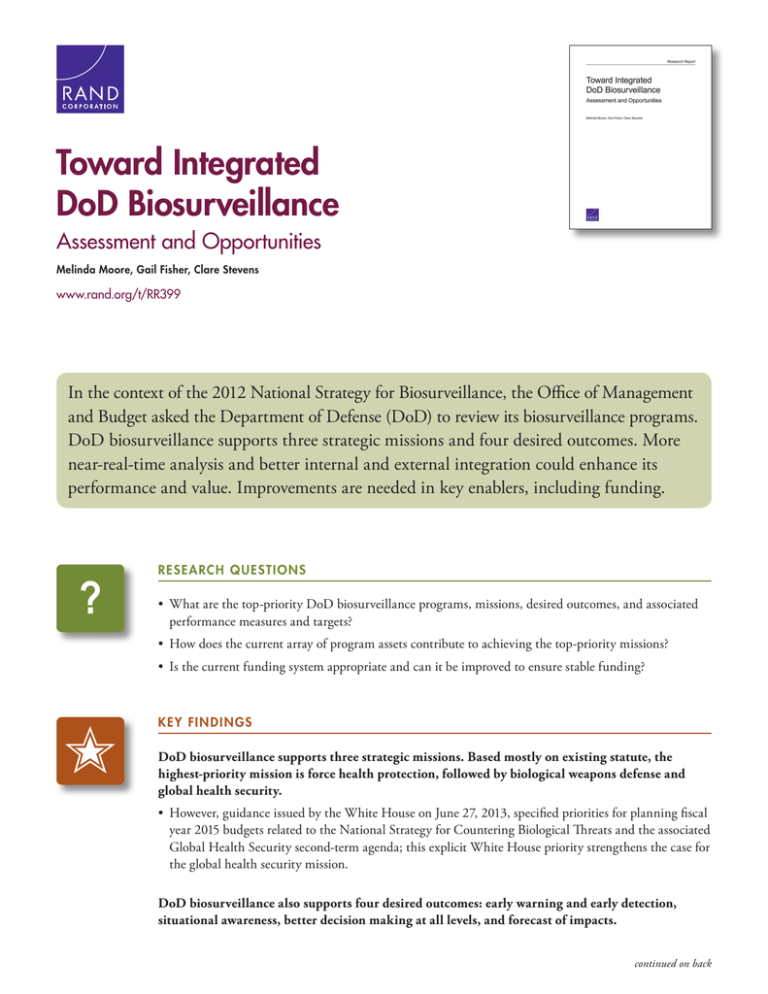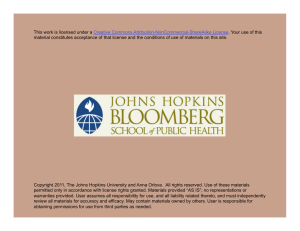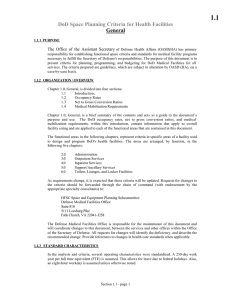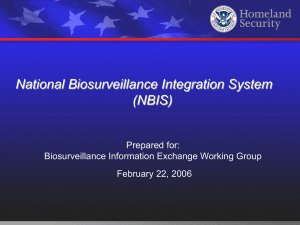Toward Integrated DoD Biosurveillance Assessment and Opportunities
advertisement

C O R P O R AT I O N Toward Integrated DoD Biosurveillance Assessment and Opportunities Melinda Moore, Gail Fisher, Clare Stevens www.rand.org/t/RR399 In the context of the 2012 National Strategy for Biosurveillance, the Office of Management and Budget asked the Department of Defense (DoD) to review its biosurveillance programs. DoD biosurveillance supports three strategic missions and four desired outcomes. More near-real-time analysis and better internal and external integration could enhance its performance and value. Improvements are needed in key enablers, including funding. ? Rese a rc h Q u esti o ns • What are the top-priority DoD biosurveillance programs, missions, desired outcomes, and associated performance measures and targets? • How does the current array of program assets contribute to achieving the top-priority missions? • Is the current funding system appropriate and can it be improved to ensure stable funding? ✭ K e y Fi n di n gs DoD biosurveillance supports three strategic missions. Based mostly on existing statute, the highest-priority mission is force health protection, followed by biological weapons defense and global health security. • However, guidance issued by the White House on June 27, 2013, specified priorities for planning fiscal year 2015 budgets related to the National Strategy for Countering Biological Threats and the associated Global Health Security second-term agenda; this explicit White House priority strengthens the case for the global health security mission. DoD biosurveillance also supports four desired outcomes: early warning and early detection, situational awareness, better decision making at all levels, and forecast of impacts. continued on back Programs and measures that address priority missions—force health protection in particular— and desired outcomes should be prioritized over those that do not do so. More near-real-time analysis and better internal and external integration could enhance the performance and value of the biosurveillance enterprise for DoD decision makers, especially for current situational awareness. Improvements are needed in key enablers, including the need for explicit doctrine/policy, efficient organization and governance, and increased staffing and improved facilities for the Armed Forces Health Surveillance Center (AFHSC). • AFHSC has requested additional funding to fully implement its responsibilities under the 2012 Memorandum of Understanding between the Assistant Secretaries of Defense for Health Affairs and for Nuclear, Chemical, and Biological Defense Programs. Additional responsibilities for coordinating the entire DoD biosurveillance enterprise would need concomitant resourcing. There is not a single, unified funding system for the DoD biosurveillance enterprise; the multiple current funding systems would likely benefit from an organizing mechanism with the authority to manage and control funds to meet enterprise goals. To Do R ecomm en dati o ns • Prioritize programs and measures that address priority missions, especially force health protection, and desired outcomes. • Pursue more near-real-time analysis and better internal and external integration of the biosurveillance enterprise to enhance its performance and value. • Improve key enablers, such as explicit doctrine/policy, efficient organization and governance, and increased staffing, funding, and improved facilities for the Armed Forces Health Surveillance Center. • Establish a single, unified funding system for the DoD biosurveillance enterprise. A RRO YO CENT ER RAND Arroyo Center is the Army’s federally funded research and development center for studies and analyses. Its mission is to help Army leaders make decisions that are informed by objective, high-quality analysis. For more information visit Arroyo’s website at www.rand.org/ard.







